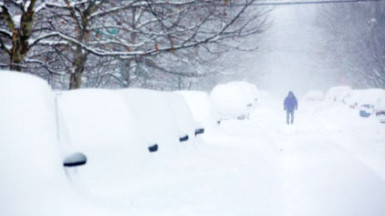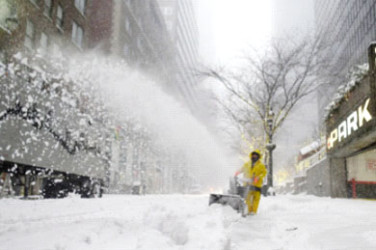NEW YORK/WASHINGTON (Reuters) – A blizzard that has paralyzed much of the US East Coast intensified yesterday, bringing the nation’s capital to a standstill and forcing the closure of roads, bridges and tunnels into New York, the largest city in the country.
At least 13 people have been killed in weather-related car crashes in Arkansas, North Carolina, Kentucky, Ohio, Tennessee and Virginia. One person died in Maryland and three in New York while shovelling snow.

After dumping nearly two feet (60 cm) of snow on the Washington area overnight, the storm unexpectedly gathered strength as it spun northward and headed into the New York metropolitan area, home to about 20 million people.
With the storm persisting through the night, accumulations of between 24 and 28 inches (60 to 71 cm) of snow are expected in New York City, northern New Jersey and western Long Island, with winds gusting to 45 mph (72 kph), the National Weather Service said. Visibility is expected to be one-quarter of a mile or less.
Mayor Bill de Blasio said that the accumulation could be two feet or more “when all is said and done, making it in the top five of storms to hit New York City.”
New York Governor Andrew Cuomo declared a state of emergency as 10 other state governors have done. He also announced a ban on all travel on New York City area roads and on Long Island, except for emergency vehicles, as of 2.30 pm. All bridges and tunnels into the city from New Jersey were also closed and would be until the early hours of today, de Blasio said.
Subways running above ground and trains operated by the Long Island Rail Road and Metro-North halted service at 4 pm EST because snow falling at a rate of 3 inches (8 cm) per hour proved too much for ploughs on roads and railways, Cuomo said.
The impact of the travel ban on the New York’s financial services industry is seen as minimal over the weekend, and it was too soon to tell how much the heavy snow will affect Wall Street’s reopening tomorrow.
On Broadway, however, the impact was immediate. Theatres cancelled Saturday matinee and evening performances at the urging of the mayor.

“We’re loving it. We definitely want to come back,” said Michelle Jones, 46, a mortgage company controller from Atlanta who had tickets to see ‘The Phantom of Opera’ with her daughter.
While authorities in New York and New Jersey halted public transportation, the Washington Metropolitan Area Transit Authority took the rare step of suspending operations through Sunday in the capital city.
“The forecasts suggest that the snow will wrap up late tonight or in the very early hours of the morning,” Washington Mayor Muriel Bowser said at a press conference. “But it doesn’t make it any less dangerous. We expect continued high winds throughout the area which will continue to make the conditions and visibility very poor.”
More than 10,200 US flights were cancelled from Friday through Monday, according to transportation officials the aviation data and tracking website FlightAware.com.
United Airlines said yesterday that it would not operate at Washington-area airports Saturday and Sunday, and would gradually resume service on Monday. The airline plans to start “very limited operations” on Sunday afternoon at its Newark, New Jersey, hub and other New York area airports.
The brunt of the blizzard reached the New York City area after battering Washington, where snow had piled up outside the White House and across the US capital.
Some residents said they just could not resist seeing famous monuments frosted with snow.
“We haven’t made snow angels yet, but we’re looking forward to doing that in front of the White House,” said Robert Bella Hernandez, 38. “We’re just going to walk around, see some snow covered DC landmarks. And then when it’s unsafe, maybe go back in for a minute.”
The record high of 28 inches of snow in Washington was set in 1922 and the deepest recent snowfall was 17.8 inches in 2010.


